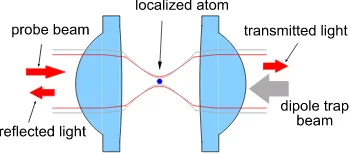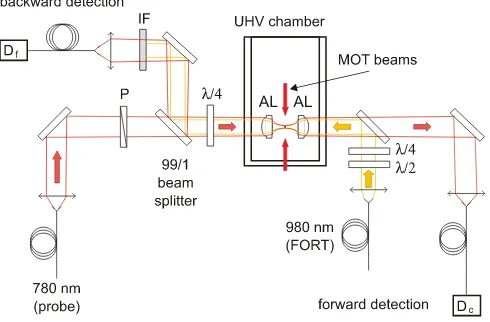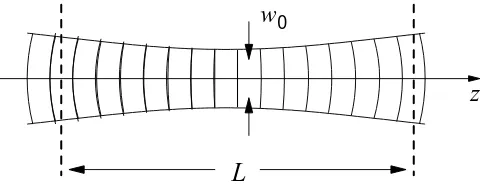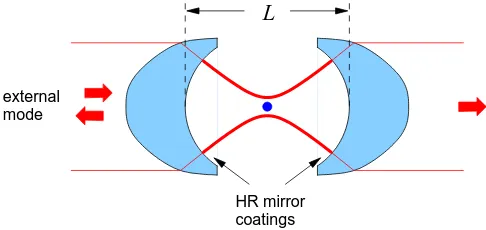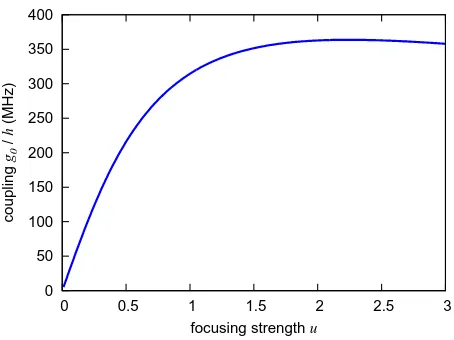arXiv:1006.2191v1 [quant-ph] 11 Jun 2010
Syed Abdullah Aljunid1
, Brenda Chng1
, Martin Paesold1,2
, Gleb Maslennikov1
and Christian Kurtsiefer1∗
1
Centre for Quantum Technologies / Department of Physics, National University of Singapore, Singapore and 2
ETH Z¨urich, Switzerland
(Dated: June 14, 2010)
We consider the near-resonant interaction between a single atom and a focused light mode, where a single atom localized at the focus of a lens can scatter a significant fraction of light. Complementary to previous experiments on extinction and phase shift effects of a single atom, we report here on the measurement of coherently backscattered light. The strength of the observed effect suggests com-bining strong focusing with the well-established methods of cavity QED. We consider theoretically a nearly concentric cavity, which should allow for a strongly focused optical mode. Simple estimates show that in a such case one can expect a significant single photon Rabi frequency. This opens new perspectives and a possibility to scale up the system consisting of many atom+cavity nodes for quantum networking due to a significant technical simplification of the atom–light interfaces.
I. INTRODUCTION
In order to manage more complex tasks in quantum communication and information processing, it became obvious in the recent years that different physical systems have different strengths in various quantum information processing primitives. Thus, different quantum systems have to be combined for more complex tasks, and inter-faces between various microscopic systems and photons in the optical domain — as quantum information carriers which allow easy decoherence-free transport of quantum information — are of strong interest.
To accomplish a substantial information exchange be-tween photons and microscopic systems like atoms, or to implement an atom-mediated interaction between fly-ing qubits, a strong interaction between the photons and atoms is essential. So far, the canonical approach to this problem in the makes use of cavities with a high finesse and a small mode volume. This significantly enhances the electrical field of a single photon such that the atomic state could be substantially affected [1]. This technique has been proven to be amazingly successful [2–5], but it remains a technological challenge to work with such cavi-ties. Despite the dramatic success in increasing resonator finesse with smart dielectric structures [4], the bulk of cavity QED experiments in the optical domain still makes use of cavities based on sophisticated dielectric coatings [6–8], which are still an art to make. This, together with the challenge to stabilize the cavities against vibrations make it seem hard to scale up such atom–light interfaces to the desired quantum networks [9].
An alternative approach for increasing the electromag-netic field at the location of an atom considers strong focusing of the optical mode. This technique has been applied to observe strong interaction of the electromag-netic fields with molecules [10, 11], quantum dots [12], and single atoms [13, 14] as possibly one of the clean-est physical systems for quantum information processing.
∗christian.kurtsiefer@gmail.com;http://www.quantumlah.org
FIG. 1: Concept of an atom interacting with a Gaussian light mode using a pair of lenses.
The basic configuration of such an interaction scheme is shown in figure 1. Efforts are under way to reach near perfect coupling between field modes and electrical dipole transitions in ions [15].
In this paper, we report on measurements of the reflec-tion of light in a tightly focused mode by a single atom in section II, complementing the observation of trans-mission [13] and phase shift [14]. The essence of such experiments can be understood by treating the light field classically, since the focusing geometry only modifies the boundary conditions of the electromagnetic field.
FIG. 2: Experimental setup for measuring extinc-tion/reflection. A single atom is localized in the focus of two lenses with a far-off resonant trap, and exposed to the focused probe light field. Transmission and reflection measurements are carried out with single photon detectors behind single mode fibers in forward and backward direction.
II. EXPERIMENTAL OBSERVATION OF BACKSCATTERING FROM A SINGLE ATOM
To complement our earlier measurements on the trans-mission of a light beam focused on an atom and the atom-induced phase shift, we measured the reflection of light into the source mode by the atom. Such a reflectivity has been shown to be perfect in the idealized case of an electrical field that exactly matches a directional dipole wave [18]. However, such an electric field is not easily prepared in practice, so light fields with a Gaussian en-velope are commonly used instead, as they emerge in a good approximation from optical fibers. There, the max-imal reflectivity for circularly polarized light is limited to about 53% [19].
A schematic outline of our experiment is shown in fig-ure 2. A single 87
Rb atom is localized at the focus of two aspheric lenses with a circularly polarized far-off res-onant dipole trap (FORT) with an operating wavelength of 980 nm in an ultrahigh vacuum chamber. Prior to localizing the atom, its kinetic energy is lowered to 15– 30µK with the aid of a magneto-optical trap and a sub-sequent molasses cooling step. A probe beam emerg-ing from a semerg-ingle mode optical fiber with a wavelength of λ =780 nm is prepared into a circular polarization state, and sent through the same lens pair in a counter-propagating direction. Its frequency can be tuned over the transition from the 5S1/2, F = 2 electronic ground state to the 5P3/2, F = 3 excited state, and has a waist parameter of wL=1.25 mm just before the focusing lens withf = 4.5 mm. The transmitted light is collimated by an identical lens, and coupled into another single mode optical fiber, from where it reaches a photon counting module, Dc. To capture the reflected light, a 99:1 beam splitter is inserted into the probe beam prior to the lens arrangement, such that most of the reflected light can be
91 92 93 94 95 96 97 98 99 100
20 25 30 35 40 45 50
0 0.05 0.1 0.15 0.2
transmission
T
(%)
reflection
R
(%)
detuning ∆/2π (MHz)
FIG. 3: Combined results for transmission and reflection from the atom–lens setup as a function of the detuning with re-spect to the unperturbed atomic transition. For this focusing strength, we observe a maximal reflection of 0.17% of the incoming power (open circles), coinciding with the minimal transmission of 92% (filled circles).
directed into another single mode optical fiber and de-tected by a second single photon detector, Df. Dichroic mirrors and an interference filter are used to suppress the residual trap light propagating in this direction. Detec-tor Df is also used to observe the fluorescence from an atom in the FORT during the loading process from the magneto-optical trap. To avoid optical pumping into the
F = 1 ground state, re-pump light at λ= 795 nm reso-nant with the D1 line is used to transfer the atom back to the approximate two-level system via the 5P1/2, F = 2 level. Details of the loading and state preparation se-quence can be found in [13].
The results from the transmission and reflection mea-surement obtained by sweeping the frequency of the probe beam across the resonance are shown in figure 3. The transmission results are obtained by normalizing the events observed in detector Dc for a particular detuning in the presence of an atom to events in a time interval without the atom. Similarly, the reflectivity is obtained by normalizing the events detected with Df against the normalization events in detector Dc without an atom in the trap. On resonance, the number of events observed in detector Df was about 13 s−1
above the detector back-ground (100–400 s−1
), and the data points shown were obtained by collecting events over an integration time of 50 minutes per point. Error bars depicted in the graph represent propagated Poissonian counting statistics into the final reflection/transmission value.
Both transmission and reflection measurements seem to follow the expected Lorentzian line profile. A best fit of our data to such a profile (solid lines in figure 3) with center detuning ∆f0, full with of half maximum (FWHM)
T = 8.2±0.2%. For the reflection measurement, we find ∆f0= 36.8±0.2 MHz,δf = 8.0±0.6 MHz, and a peak reflectivity of 0.161±0.007%.
The reflection/transmission measurements show com-plementary dependency on the detuning within our ex-perimental uncertainty. The center frequency of the res-onance line is shifted to the blue due to the AC Stark shift induced by the optical dipole trap, and the observed widths are slightly larger than the natural line width of the probed D2 line (6.06 MHz).
As shown in [19], the transmission and reflection prop-erties can be derived from a dimensionless quantity
Rsc(u) = 3
which for a small focusing parameteru=wL/f has the interpretation of a scattering probability of a photon from the atom, and exhibits a maximum of about 1.4 foru≈2. The focusing parameter itself is connected to the Gaus-sian beam divergence Θ via tan Θ = u. For collection into modes overlapping with the excitation mode, the extinction 1−T and reflectivityRare given by
1−T = 1−
The amplitude coefficient of the fit to the transmission measurement for this model corresponds toRsc= 0.083± 0.002, and the reflectivity result toRsc= 0.080±0.002. Both values are in agreement within experimental uncer-tainties. In our experiment, however, we used a focus-ing parameter u= 0.278 corresponding to Rsc = 0.201. Apart from lens imperfections, a very likely explanation for this discrepancy is the delocalization of the atom from the focus due to its residual kinetic energy, which would reduce both the electrical field felt by the atom as well as the overlap of the radiated field with the receiving modes. A quantitative numerical estimation of this ef-fect is in preparation [20].
From this experiment, it seems that the transmission and reflection properties for light in a strongly focused mode are well understood, and motivates further inves-tigation of atom–light interaction in the strong focusing regime.
III. FIELD QUANTIZATION FOR FOCUSED GAUSSIAN MODES
The field quantization of Gaussian beams is relatively straightforward and has been done many times in the paraxial regime [21]. We quickly revisit one approach here, mostly to clarify the nomenclature we use later on for the strongly focused scenario. For simplicity, we begin with periodic boundary conditions and a ‘quantization length’L.
We start with an expression for the electric field oper-ator in a generalized mode decomposition,
ˆ
where the spatial dependency and polarization property of a mode j is covered by a mode function gj(x) and the time dependency by the ladder operators ˆaj,ˆa†j. The dimensional components, together with a normalization of the mode function, are lumped into the constantEωj.
The free field Hamiltonian of the total field
ˆ
then can be written as a sum of contributions from dif-ferent modesj:
ˆ be compatible with the Maxwell equations for an angu-lar frequency ofωj, and the normalization constantEωj needs to be chosen that ˆHj coincides with the Hamilto-nian of a harmonic oscillator. This leads to
Eω j =
s
~ωj
2ǫ0Vj, (6) with an effective mode volumeVj given by
Vj :=
In vacuum, electric and magnetic contributions to the total field energy are the same, such that we can reduce the above integral to the simplified expression
Vj=
In the following, we now restrict the treatment of the electromagnetic field to a single mode j of the electro-magnetic field, and drop the mode index. In paraxial optics, a Gaussian beam is characterized by the waistw0 and the longitudinal mode index, usually described by a wave numberkj. In a regime where there is no significant wavefront curvature (i.e.,L is smaller than the Rayleigh rangezR=πw20/λ), the mode function is given by
g(x) =εεεe−ρ2
/w2
0eikz, (9)
with a radial distanceρ, a transverse polarization vector
εεε, and a positionz along the propagation direction. The dispersion relation for this mode is given byω2
=c2 0(k
2 + 2/w2
z
0
w
L
FIG. 4: Quantization geometry of a Gaussian beam of a waist
w0. To discretize the mode longitudinal mode index, we
intro-duce periodic boundary conditions with a quantization length
L.
the quantization lengthL(see Fig. 4), leading to a result for the effective mode volume of
V =πLw2
/2, (10)
and consequently to a normalization constantE of
E =
r
~ω
πw2
Lǫ0
. (11)
This expression is valid in a regime where the variation of the beam waistwalong the interval inzdirection does not change, i.e., the quantization lengthL≪zR. It turns out that this restriction is actually not necessary, and we can easily extend this result to focused beams.
A. Strong focusing limit
To consider focused Gaussian beams, we keep in mind that even in a strong focusing regime (ularge), light prop-agates either in +z or −z direction, i.e., all the optical power transported in the mode has to pass through each transverse plane. Hence, the contribution to the volume integral for each slice dz in eq. (7) is independent of z. Attention only has to be payedwherethe modulus ofg(x) is referenced to 1. For the case L ≪zR treated above, the mode function can be chosen to |g(x)| = 1 on the entire optical axes. If one includes any focusing of the Gaussian mode,|g(x)|varies along the optical axes, and will show a maximum in the focus. In a regime where the paraxial approximation is still valid, we can simply use the waistw=wf in the focus in eq. (11) to obtain the correct normalization constant.
In the strong focusing regime where the paraxial ap-proximation breaks down, a slightly different approach has to be used to estimate the electrical field at the loca-tion of the atom. Again, we start with a Gaussian mode at a location far away from the focus; for convenience, we consider a configuration as depicted in figure 1. We assign a Gaussian beam waistwL at the collimated part of the beam outside the lens pair, and choose the mode function such that there, |g(x)|= 1 on the optical axis. The ratio of the electrical field amplitude on the axis be-fore the lens pair,EL, and in the focus of the system,EA,
can be expressed in a closed form for circularly polarized light. This ratio is determined by the numerical aperture of the focusing setup, which for Gaussian beams is better described by the focusing parameteru=wL/f. One can show [19] that
E
A
EL
2
=π 2
w2
LRsc(u)
3λ2 . (12) We now can take the normalization expression from eq. (11) with a waist wL before the lens, and multiply it with the field ratio determined by eq. (12) due to the focusing; we arrive at
E=
s
π~ωRsc(u)
3λ2Lǫ 0
. (13)
The normalization constant now only depends on the wavelength, quantization length and focusing strength (or divergence) of the mode.
B. Wave packets
To include wave packets of light in a quantized field de-scription, a continuous mode decomposition is helpful, in which ‘localized photons’ can be expressed as a superpo-sition of contributions from a continuous one-dimensional spectrum of modes, labeled by a continuous longitudinal wave number k = ω/c, or the angular frequency ω di-rectly. Our treatment above is valid for such a case if we apply the simple transitionL→ ∞, and replace the discrete sum over modes e.g. in eq. (3) by an integral:
X
j
→ L
2πc
Z
dω (14)
The expression for the normalization constantsEstill can be taken from the expressions above, and in all physically meaningful quantities the length L should not appear anymore. Such a field decomposition allows the treat-ment of wave packets of various shapes. In particular, it allows to understand the dynamics of the absorption of single photon states [15, 22] or pulsed coherent states of the field.
C. Combination with optical cavities
The field-enhancing effect of a small focus (‘hourglass modes’) has been identified as a method for enhancement of the electrical field in an optical cavity at the location of atoms before [16, 17]. Here, we would like to extend the description of the electrical field to strongly focused modes.
The simplest transition from the treatment presented above to a resonant structure involves a ring cavity, which reflects exactly the periodic boundary conditions above. Thus, we can directly use eq. (13) for the normalization constantE for this case.
For the more conventional cavities with a standing wave field mode, quantization can be adapted from the case of periodic boundary conditions by modifying the propagating part of the mode: the eikz term has to be replaced with the standing wave component sin(kz) for a proper choice of origin, andk=N π/Lwith an integerN. Compared to periodic boundary conditions, the sin2
(kz) modulation in the field energy density reduces the effec-tive mode volume by a factor of 2, and the normalization constantE is given by
E=
s
2π~ωRsc(u) 3λ2Lǫ
0
. (15)
For a standing wave resonator, the field amplitude has also a strong variation in longitudinal direction. To en-sure a strong coupling of an atom with the resonator mode, the atom needs to be localized close to the anti-node of the standing wave.
IV. ESTIMATION OF COUPLING PARAMETERS
Since a large fraction of the scientific work on strong atom–light coupling is carried out where field modes are supported by a cavity with a discrete mode spectrum, we estimate quantitatively the combination of the field enhancement in a cavity by strong focusing, as shown in figure 5. Similarly to [16], two spherical surfaces with a separationLform a cavity such that the cavity mode corresponds to a the focused light field configuration in the above discussed strong focusing regime, and is char-acterized by a focusing parameter u. We assume that the cavity mode has still a Gaussian transverse envelope, although for a strong focusing regime, the cavity is close to the edge of the stability region.
A. Interaction Hamiltonian
With the electrical field operator for an optical mode overlapping with an atom we can easily obtain the cou-pling strength necessary for a treatment of a two-level atom and the resonant field in a Jaynes–Cummings model. The interaction Hamiltonian of the field with
HR mirror coatings external
mode
L
FIG. 5: Concept of an atom in a cavity with a strongly focused resonator mode and a cavity lengthL, coupling to collimated running modes with a pair of anaclastic lenses.
an atomic electric dipole momentdis given by
ˆ
HI = ˆEA·dˆ
= iEdeff |eihg|agˆ (xA)− |gihe|ˆa†g∗(xA)
=: ig0 |eihg|aˆ− |gihe|ˆa†)
, (16)
where we chooseg(xA) = 1 at the location of the atom. We used an effective dipole matrix elementdeff, which,
for a field polarization matching the transition between the two levels and a unit Clebsch-Gordan coefficient, is related to the decay time constantτ for the atomic tran-sition by
deff =
r
3ǫ0hλ3
8π2τ . (17) Therein, h is the Planck constant and λ the vacuum wavelength corresponding to the optical transition be-tween ground- and excited state [23]. Usually, the cou-pling strength g0 = Edeff is quoted to characterize an atom+cavity system, which for a standing wave cavity is given by
g0=~
r
πcRsc(u)
τ L . (18)
For the D2 transition in a 87
Rb atom with a natural lifetime ofτ= 26.25 ns and a cavity length ofL= 10 mm, the expected coupling constantg0is shown in figure 6 as a function of the focusing parameteru. One can see that even for moderate focusing parameters, very large values for the coupling constant can be expected.
B. Combining lenses and cavity
0 50 100 150 200 250 300 350 400
0 0.5 1 1.5 2 2.5 3
coupling
g0
/
h
(MHz)
focusing strength u
FIG. 6: Coupling parameter g0 as defined in the
Jaynes-Cummings-Hamiltonian in eq. (16) for a two-level transition in 87
Rb as a function of the focusing parameter u. Even for moderate focusing, large coupling constants exceeding the natural line width can be expected.
light fields [19], such cavity modes require that the mir-ror surfaces be strictly spherical with a curvature radius
rc, and L <∼ 2rc. We approximated the focal position for the focused mode as coinciding with the center of the wave front for the focusing calculations, but this does not imply that such a cavity would be concentric.
Practical issues aside, it has been known for a while that the transformation of the cavity mode onto a colli-mated Gaussian beam can performed without any error [24, 25]. For a focal lengthf, it can be shown that the shape of the convex surface of this anaclastic lens is an ellipse with half axes f n/(n+ 1) in longitudinal, and
fp(n−1)/(n+ 1) in transverse direction for a fixed re-fractive indexnof the lens.
Practically, it seems that a half-opening angle for the cavity mode of about Θ0<∼45◦can be achieved, limiting the focusing strength to aboutu0= tan Θ0<∼1.
Diffrac-tion at the edges of this resonator will limit the achievable finesse [26]. Under the assumption that the cavity eigen-mode still has a Gaussian angular profile, the round-trip diffraction lossǫat the edges of the resonator for a mode with focusing strengthufor such a cavity can be roughly estimated by
ǫ≈e−2u2
0/u 2
. (19)
For a focusing parameteru≈0.5 andu0≈1, this loss is on the order of 10−3
. With this, a cavity finesse around 100 seems achievable, and the strong coupling regime would be reachable with comparatively large cavity ge-ometries.
V. CONCLUSION
We have observed the back reflection of a coherent light field from a single atom in near resonance with the light field, and could show that within the limited localization of the atom in our experiment, we understand this in a semiclassical picture for strongly focused light fields pre-sented earlier [19]. We also prepre-sented a method of quan-tizing the fields in such a strongly focused geometry. We find that, when using this geometry in a cavity configura-tion with its discrete mode spectrum, a coupling constant of an atom with this field much larger than the sponta-neous decay time of an atom can be obtained, even for cavities with a relatively large mirror separation. This may imply a technical simplification of atom-photon in-terfaces to a point that quantum information processing devices based on such interfaces [9, 27] may become much more realistic.
Acknowledgements
This work is supported by the National Research Foun-dation & Ministry of Education, Singapore.
[1] H. J. Kimble, Physica ScriptaT76, 127 (1998).
[2] J. Ye, D. W. Vernooy, and H. J. Kimble, Phys. Rev. Lett.
83, 4987 (1999).
[3] H. Mabuchi and A. C. Doherty, Science298, 1372 (2002). [4] D. K. Armani, T. J. Kippenberg, S. M. Spillane, and
K. J. Vahala, Nature421, 925 (2003).
[5] M. Hennrich, A. Kuhn, and G. Rempe, Phys. Rev. Lett.
94, 053604 (2005).
[6] C. J. Hood, H. J. Kimble, and J. Ye, Phys. Rev. A64, 033804 (2001).
[7] T. Aoki, B. Dayan, E. Wilcut, W. P. Bowen, A. S. Parkins, T. J. Kippenberg, K. J. Vahala, and H. J. Kim-ble, Nature443, 671 (2006).
[8] T. Steinmetz, Y. Colombe, D. Hunger, T. W. H¨ansch, A. Balocchi, R. J. Warburton, and J. Reichel, Appl. Phys. Lett.89, 111110 (2006).
[9] J. I. Cirac, P. Zoller, H. J. Kimble, and H. Mabuchi, Phys. Rev. Lett.78, 3221 (1997).
[10] I. G. I, G. Wrigge, P. Bushev, G. Zumofen, M. Agio, R. Pfab, and V. Sandoghdar, Phys. Rev. Lett.98, 033601 (2007).
[11] G. Wrigge, I. Gerhardt, J. Hwang, G. Zumofen, and V. Sandoghdar, Nature Physics4, 60 (2008).
[12] N. Vamivakas, M. Atature, J. Dreiser, S. T. Yilmaz, A. Badolato, A. K. Swan, B. B. Goldberg, A. Imamoglu, and M. S. Unlu, Nano Lett.7, 2892 (2007).
[13] M. K. Tey, Z. Chen, S. A. Aljunid, B. Chng, F. Huber, G. Maslennikov, and C. Kurtsiefer, Nature Physics4, 924 (2008), URLarXiv:0802.3005.
[14] S. A. Aljunid, M. K. Tey, B. Chng, T. Liew, G. Maslen-nikov, V. Scarani, and C. Kurtsiefer, Phys. Rev. Lett.
[15] M. Sondermann, R. Maiwald, H. Konermann, N. Lindlein, U. Peschel, and G. Leuchs, Appl. Phys. B
89, 489 (2007).
[16] S. E. Morrin, C. C. Yu, and T. W. Mossberg, Phys. Rev. Lett.73, 1489 (1994).
[17] A. Haase, B. Hessmo, and J. Schmiedmayer, Opt. Lett.
31, 268 (2006).
[18] G. Zumofen, N. M. Mojarad, V. Sandoghdar, and M. Agio, Phys. Rev. Lett.101, 180404 (2008).
[19] M. K. Tey, S. A. Aljunid, F. Huber, B. Chng, Z. Chen, G. Maslennikov, and C. Kurtsiefer, New Journal of Physics11, 043011 (2009).
[20] C. Teo, J. Lee, et al. (2010), in preparation.
[21] P. Meystre and M. Sargent III, Elements of Quantum
Optics (3rd ed.)(Springer Verlag, Berlin, 1999). [22] M. Stobi´nska, G. Alber, and G. Leuchs,
Europhys. Lett. 86, 14007 (2009), URL
http://arxiv.org/abs/0808.1666v2.
[23] C. Cohen-Tannoudji, J. Dupont-Roc, and G. Grynberg,
Photons and Atoms: Introduction into quantum electro-dynamics (Wiley Interscience, New York, 1998). [24] I. Sahl, On burning mirrors and lenses (Publisher
un-known, Baghdad, 984), (See also next reference). [25] R. Rashed, Isis81, 464 (1990).
